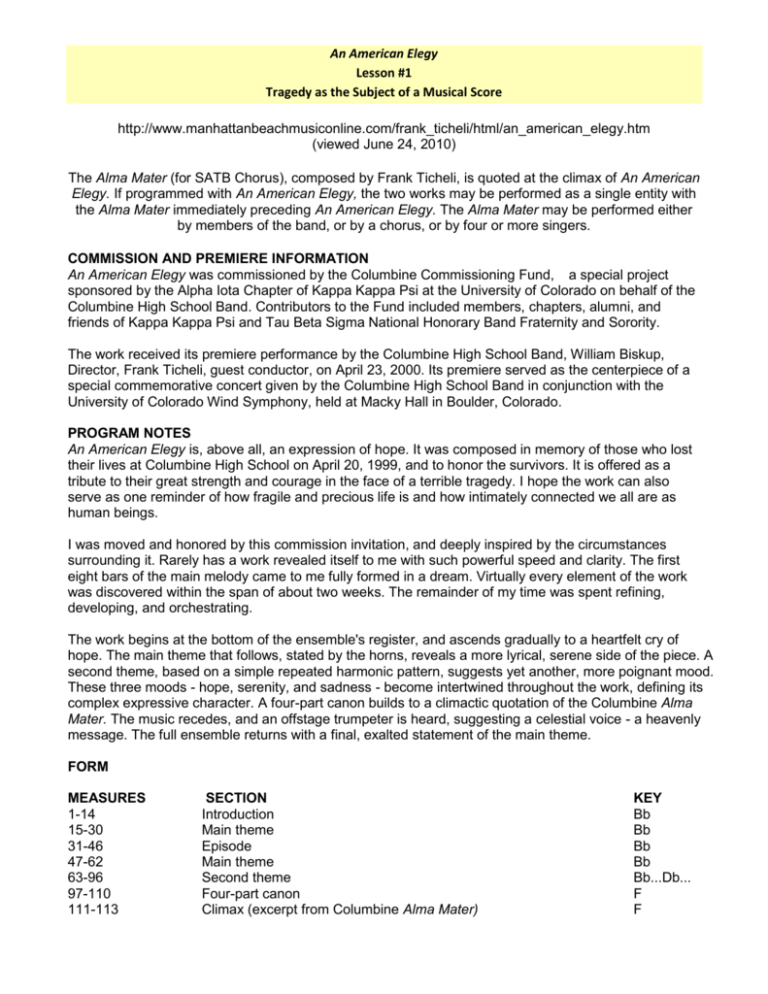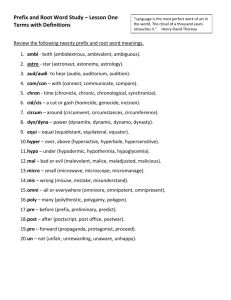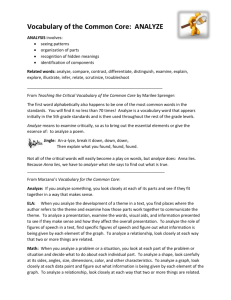
An American Elegy
Lesson #1
Tragedy as the Subject of a Musical Score
http://www.manhattanbeachmusiconline.com/frank_ticheli/html/an_american_elegy.htm
(viewed June 24, 2010)
The Alma Mater (for SATB Chorus), composed by Frank Ticheli, is quoted at the climax of An American
Elegy. If programmed with An American Elegy, the two works may be performed as a single entity with
the Alma Mater immediately preceding An American Elegy. The Alma Mater may be performed either
by members of the band, or by a chorus, or by four or more singers.
COMMISSION AND PREMIERE INFORMATION
An American Elegy was commissioned by the Columbine Commissioning Fund, a special project
sponsored by the Alpha Iota Chapter of Kappa Kappa Psi at the University of Colorado on behalf of the
Columbine High School Band. Contributors to the Fund included members, chapters, alumni, and
friends of Kappa Kappa Psi and Tau Beta Sigma National Honorary Band Fraternity and Sorority. The work received its premiere performance by the Columbine High School Band, William Biskup,
Director, Frank Ticheli, guest conductor, on April 23, 2000. Its premiere served as the centerpiece of a
special commemorative concert given by the Columbine High School Band in conjunction with the
University of Colorado Wind Symphony, held at Macky Hall in Boulder, Colorado. PROGRAM NOTES
An American Elegy is, above all, an expression of hope. It was composed in memory of those who lost
their lives at Columbine High School on April 20, 1999, and to honor the survivors. It is offered as a
tribute to their great strength and courage in the face of a terrible tragedy. I hope the work can also
serve as one reminder of how fragile and precious life is and how intimately connected we all are as
human beings.
I was moved and honored by this commission invitation, and deeply inspired by the circumstances
surrounding it. Rarely has a work revealed itself to me with such powerful speed and clarity. The first
eight bars of the main melody came to me fully formed in a dream. Virtually every element of the work
was discovered within the span of about two weeks. The remainder of my time was spent refining,
developing, and orchestrating.
The work begins at the bottom of the ensemble's register, and ascends gradually to a heartfelt cry of
hope. The main theme that follows, stated by the horns, reveals a more lyrical, serene side of the piece. A
second theme, based on a simple repeated harmonic pattern, suggests yet another, more poignant mood.
These three moods - hope, serenity, and sadness - become intertwined throughout the work, defining its
complex expressive character. A four-part canon builds to a climactic quotation of the Columbine Alma
Mater. The music recedes, and an offstage trumpeter is heard, suggesting a celestial voice - a heavenly
message. The full ensemble returns with a final, exalted statement of the main theme.
FORM
MEASURES
1-14
15-30
31-46
47-62
63-96
97-110
111-113
SECTION
Introduction
Main theme
Episode
Main theme
Second theme
Four-part canon
Climax (excerpt from Columbine Alma Mater)
KEY
Bb
Bb
Bb
Bb
Bb...Db...
F
F
An American Elegy
Lesson #1
Tragedy as the Subject of a Musical Score
114-117
118-127
128-131
132-end
Bridge (based on second theme)
Offstage trumpet solo, variant of Second theme
Bridge
Main theme, final statement
F
Bb
Bb
Bb
PERFORMANCE NOTES
Introduction (measures 1-14)
The introduction, which was composed last, begins at the bottom of the ensemble's register, and
gradually ascends to an exalted statement of hope, setting the tone for the entire work. The crescendo
into measure 9 should not be held back emotionally.
Main Theme (measures 15-30)
In contrast to the unrestrained energy unleashed in the introduction, the main theme is more reflective
and serene. In my mind, it suggests the image of a head bowed in meditation or prayer, after having
been lifted skyward during the introduction. The horns will bring an understated reverence and nobility
to this melody.
Episode (measures 31-46)
The "tempo rubato" indication can be interpreted in several ways, and is left to the discretion of the
conductor. Originally, I tried to show exactly where the tempo should push ahead and pull back, but in
early rehearsals I found these indications to be restrictive. Strive for a subtle elasticity, free and fluid,
but not too disruptive.
Second Theme (measures 63-96)
The second theme is accompanied by a simple repeated harmonic pattern (I-V-IV-V) over a tonic pedal.
In measures 71-78, the clarinet melody and accompaniment should move well into the background,
allowing the oboe countermelody through. In measures 91-95 the melodic line vanishes, leaving only its
harmonic framework. Perhaps the theme's absence is more poignant than its presence. The intended
effect is one of great ethereal beauty. One must observe carefully the cross-fading dynamics between
the clarinets and saxophones. The saxophones should not use much vibrato here.
Four-part canon (measures 97-110)
This section functions as one long crescendo, moving from quiet lyricism to
powerful optimism. One must strive to balance the four canonic voices (flute 1,
clarinet 1, horn 1, euphonium). This becomes even more challenging as the four
lines become reinforced by other instruments.
Climax: Excerpt from Columbine Alma Mater (measures 111-113)
The quotation of the Columbine Alma Mater is, in effect, a self-quotation. (After learning that Columbine
High School did not have a school song, I composed one for them, and they adopted it as their official
Alma Mater.) While composing the present work, I discovered that one excerpt from the new Alma
Mater would serve beautifully as the dramatic climax - in effect, joining the two pieces at the hip. (The
excerpt quoted is a setting of the words, "We are Columbine! We all are Columbine!")
Offstage trumpet solo (measures 118-127)
This is the emotional heart of the work. The offstage solo should sound quite distant and ethereal, even
other-worldly. I have found it insufficient to merely place the soloist backstage with the stage doors
open. The sound is still too "present" in this configuration.
Perhaps the most ideal situation would be to place the soloist offstage with all stage doors closed, and
An American Elegy
Lesson #1
Tragedy as the Subject of a Musical Score
furnished with a television monitor connected to a camera that is focused directly on the conductor.
It is also possible to position the soloist behind the audience in a lobby or distant balcony. At the
premiere performance, we found that merely placing the soloist in the top balcony did not produce the
desired distant effect. We solved the problem by placing the soloist in the lobby behind the balcony
(with the doors partially open so the soloist could see the conductor onstage).
Measures 118 and 119 are unmetered. That is, the conductor should not attempt to conduct the
individual beats of the offstage solo. Rather, his or her job here is to serve as a cue-giver, conducting
the downbeats of each bar. (The downbeat of measure 118 marks the release of the whole notes held
in measure 117. The downbeat of measure 119 marks the release of clarinet 1, and the entrance of
flute 1 and clarinet 3.) The conductor returns to regular metered time in measure 120.
I suggest that someone sit in the middle of the audience section to check the balance between the
offstage soloist and the onstage players.
Bridge (measures 128-131)
The initial oboe note should grow imperceptibly out of the the offstage trumpet's final note, gradually
taking over the foreground.
Final Statement (measures 132-157)
The rising suspension figures from the introduction return here. At measure 138, while they are still
ascending, the main melody returns. Both of these musical ideas progress simultaneously, creating an
unsettling tension. The tension finally resolves as the two ideas drive to a common goal: the climax at
measure 146. The energy recedes in a final moment of deep, prayer-like reflection.
—FRANK TICHELI
Instrumentation 1 Full Score 4 Flute 1 4 Flute 2 1 Oboe 1 1 Oboe 2 4 Bb Clarinet 1 4 Bb Clarinet 2 4 Bb Clarinet 3 3 Bb Bass Clarinet 1 Eb Contrabass Clarinet 1 Bb Contrabass Clarinet 1 Bassoon 1 1 Bassoon 2 3 Eb Alto Saxophone 1 3 Eb Alto Saxophone 2 2 Bb Tenor Saxophone
1 Eb Baritone Saxophone 3 Bb Trumpet 1 3 Bb Trumpet 2 3 Bb Trumpet 3 2 F Horn 1 2 F Horn 2 2 Trombone 1 2 Trombone 2 2 Trombone 3 3 Euphonium B.C. 2 Euphonium T.C. 4 Tuba 1 String Bass
2 Timpani 3 Percussion 1 3 Percussion 2
Copyright © 2000 Manhattan Beach Music. All Rights Reserved.









